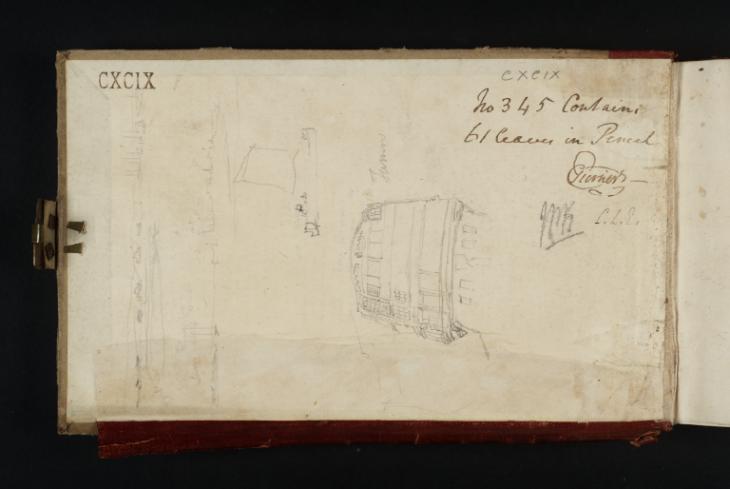Joseph Mallord William Turner River Scenes and Decorated Stern of a Ship c.1821
Image 1 of 2
Inside front cover of sketchbook
Joseph Mallord William Turner,
River Scenes and Decorated Stern of a Ship
c.1821
(Inside front cover of sketchbook)
Joseph Mallord William Turner 1775–1851
Inside Front Cover:
River Scenes and Decorated Stern of a Ship c.1821
D40691
Pencil on white wove paper, 112 x 190 mm
Inscribed by Turner in pencil ‘[?Transom]’ at centre, ascending vertically, ‘[?Land]’ and ‘[?Grey]’ towards bottom left, ascending vertically
Blind-stamped with Turner Bequest monogram towards top right
Inscribed by later hands in ink and pencil (see main catalogue entry)
Inscribed in pencil ‘CXCIX’ top right
Stamped in black ‘CXCIX’ top left
Inscribed by Turner in pencil ‘[?Transom]’ at centre, ascending vertically, ‘[?Land]’ and ‘[?Grey]’ towards bottom left, ascending vertically
Blind-stamped with Turner Bequest monogram towards top right
Inscribed by later hands in ink and pencil (see main catalogue entry)
Inscribed in pencil ‘CXCIX’ top right
Stamped in black ‘CXCIX’ top left
Accepted by the nation as part of the Turner Bequest 1856
References
1909
A.J. Finberg, A Complete Inventory of the Drawings of the Turner Bequest, London 1909, vol.I, p.607, CXCIX – “Medway” Sketch Book, as ‘On inside of covers, several slight views; also a stern of a ship of the line, &c.’.
As per Finberg’s description of the ‘inside of covers’, Turner describes several views on this page, as well as the stern of a ship of the line.1 Made with the sketchbook turned vertically, the topmost prospect reveals a panoramic impression of a river scene, with moored fishing vessels visible at far right. Seven deftly marked masts stand in a cluster, breaking through the horizon which is picked up on either side. The reasonably flat landscape is punctuated by small, angular dwellings, which peter out towards the left as the topography ascends slightly. A pool or section of water seems to be indicated on the left, as well as another at right, presumably responsible for the buoyancy of the vessels. There appears to be, however, a portion of dry land between the two, to the immediate right of centre.
Also made with the page oriented vertically, the second view from the top is an identically proportioned panorama with a similar theme. At right is a cluster of buildings, and a moored fishing boat seems to be hauled up on the shore at the leftmost periphery. From this central point land becomes water, and towards far left two masts stand tall against the horizon. At far left another bank of land is delineated, indicating a river setting. A brewing storm is indicated by delicately rendered but cyclically churning pencil lines, and pregnant clouds hang low above the sailing boats.
Immediately below these panoramic views, to the right of them if viewed according to the orientation of the book’s foliation, there is another sketch made vertically. It describes a small sailing vessel, manned by a fisherman protected from the elements by a distinctive sou’wester hat. This figure is seated towards the back of the boat, at its leftmost end near the rudder. A large square sail flaps in the wind in the space above the sailor’s head, and the slim boat seems on the brink of forging a course over the edge of the page.
At the centre of the sheet is the decorated stern of a ship of the line composed with the page turned vertically. Finberg notes this sketch specifically in his inventory entry for this book.2 Detail is picked out towards the left edges of the drawing, where Turner describes latticed windows and some of the decorative carving which embellishes the joins. His pencil is hard and sharp and as he captures the maritime craftsmanship. Other parts of the boat’s architecture are left completely blank. Brief lines to the left of the stern might indicate the bulging hull, but are unsubstantiated to any definitive degree.
The most prominent inscription is that of Turner’s executors, and is situated in the top right corner of the page, orientated according to the foliation of the sketchbook. It displays the book’s original schedule number as endorsed by Henry Scott Trimmer, Charles Turner, John Prescott Knight and Charles Lock Eastlake. Rendered in ink, it reads: ‘No 345 Contains | 61 leaves in Pencil | C Turner –’, and initialled in pencil ‘JPK’, and ‘C.L.E.’ underneath.
Maud Whatley
January 2016
How to cite
Maud Whatley, ‘River Scenes and Decorated Stern of a Ship c.1821 by Joseph Mallord William Turner’, catalogue entry, January 2016, in David Blayney Brown (ed.), J.M.W. Turner: Sketchbooks, Drawings and Watercolours, Tate Research Publication, February 2017, https://www


